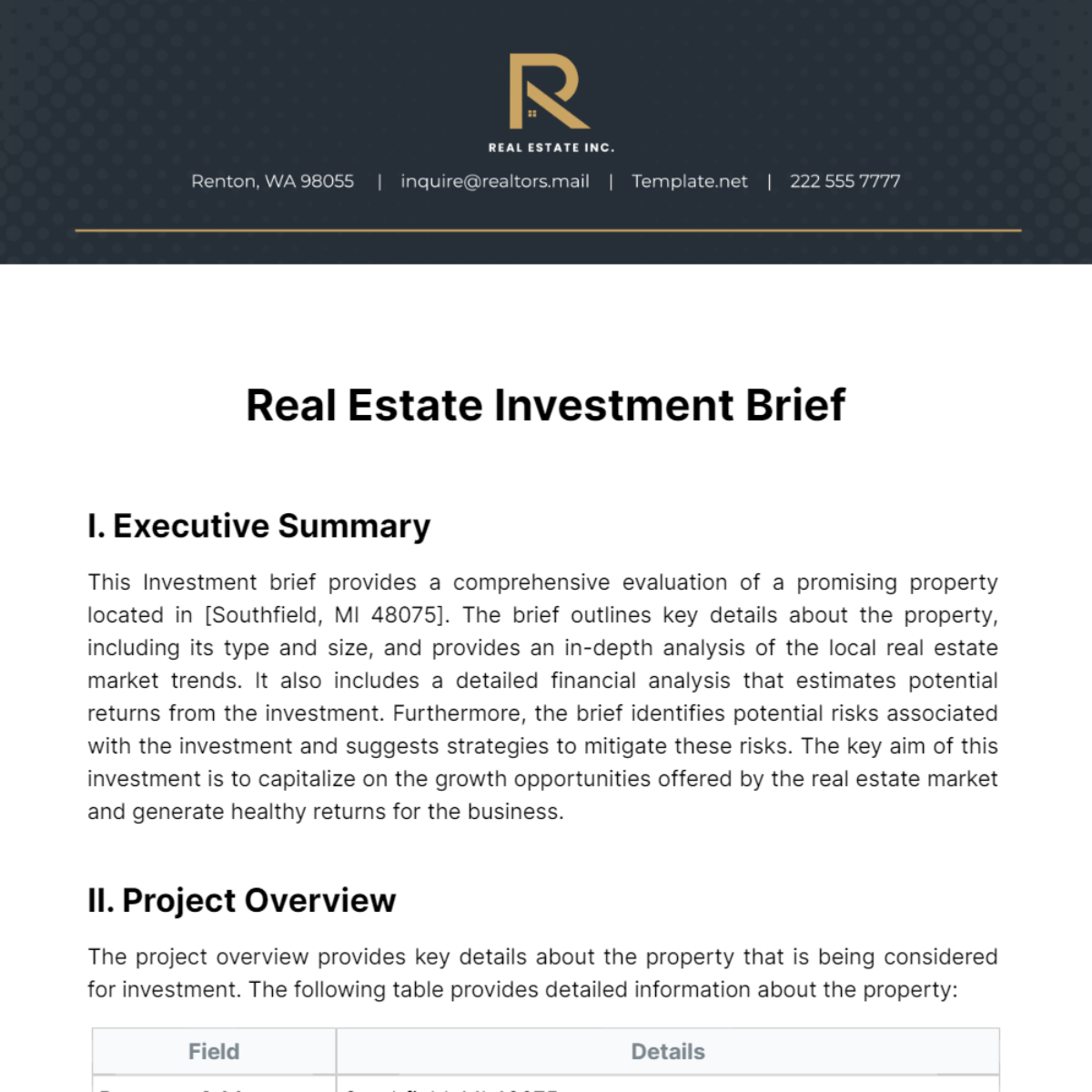Free Real Estate Investment Brief

I. Executive Summary
This Investment brief provides a comprehensive evaluation of a promising property located in [Southfield, MI 48075]. The brief outlines key details about the property, including its type and size, and provides an in-depth analysis of the local real estate market trends. It also includes a detailed financial analysis that estimates potential returns from the investment. Furthermore, the brief identifies potential risks associated with the investment and suggests strategies to mitigate these risks. The key aim of this investment is to capitalize on the growth opportunities offered by the real estate market and generate healthy returns for the business.
II. Project Overview
The project overview provides key details about the property that is being considered for investment. The following table provides detailed information about the property:
Field | Details |
|---|---|
Property Address: | Southfield, MI 48075 |
Type of Property: | Multi-family Residential Building |
Size of Property: | 10,000 sq ft |
The property, located at [Southfield, MI 48075], is a multi-family residential building. Its size is [10,000] sq ft. The property’s type and size are particularly important. As a multi-family residential building, it has the potential to generate multiple streams of rental income. The size of the property, [10,000] sq ft, provides ample space for tenants, which can make the property more attractive and potentially command higher rents. Overall, the property presents an excellent opportunity for capital appreciation and steady income through rental yields.
III. Market Analysis
The market analysis provides key insights into the real estate market in [Southfield, MI 48075]. Understanding these market trends is crucial as they can significantly impact the potential returns from the investment. The following table provides key market indicators:
Indicator | Value |
|---|---|
Population Growth | 1.5% |
Job Growth | 2.3% |
Median Household Income | $75,000 |
A. Population Growth
The population growth rate in [Southfield, MI 48075] is [1.5]%. This is an important indicator as it can influence the demand for housing in the area. A growing population often leads to increased demand for housing, which can drive up property values and rental rates.
B. Job Growth
The job growth rate in the area is [2.3]%. Job growth can have a significant impact on the real estate market as areas with strong job growth tend to attract more people, leading to increased demand for housing. This can result in higher property values and rental rates.
C. Median Household Income
The median household income in the area is [$75,000]. This is a key indicator as it can influence the affordability of housing. Areas with higher median household incomes can often support higher property values and rental rates.
Overall, market analysis not only helps in assessing the potential returns but also in identifying potential risks. For instance, areas with slow population growth or declining job growth could pose risks as they might lead to lower demand for housing. Therefore, understanding these market trends can help in making informed investment decisions and in developing effective risk mitigation strategies.
IV. Financial Analysis
Our financial analysis takes into account various factors such as the price of the property, maintenance costs, and potential rental income. The following table provides a financial analysis for this real estate investment:
Financial Metric | Value |
|---|---|
Price of Property | $1,200,000 |
Maintenance Cost | $50,000 |
Rental Income | $150,000 |
Net Operating Income | $100,000 |
A. Price of Property
The price of the property is [$1,200,000]. This is the initial investment required to purchase the property. It’s a significant factor as it directly impacts the potential return on investment and the payback period.
B. Maintenance Cost
The annual maintenance cost for the property is estimated to be [$50,000]. These costs include regular upkeep, repairs, and property management fees. It’s important to factor in these costs when calculating the net operating income and return on investment.
C. Rental Income
The potential annual rental income from the property is estimated to be [$150,000]. This income can provide a steady cash flow and contribute to the return on investment.
D. Net Operating Income
The net operating income, which is the rental income minus the maintenance cost, is estimated to be [$100,000]. This figure provides an indication of the profitability of the property.
This financial analysis is a crucial part of the investment brief as it provides insights into the potential returns from the investment. However, it’s important to remember that these are just estimates and the actual returns can be influenced by various factors such as changes in rental rates, occupancy rates, and maintenance costs.
V. Risk Assessment and Mitigation
A. Risk Type
Market Risk: Changes in the real estate market could affect property values and rental incomes. Market risk includes factors such as an economic downturn, which could lead to a decrease in property values and rental incomes. It also includes the risk of oversupply of properties in the market, which could lead to lower rental rates and property values. Additionally, fluctuations in interest rates could affect the cost of financing for real estate investments.
Tenant Risk: There is a risk of vacancies or non-payment of rent by tenants. Tenant risk includes periods of vacancy which can result in loss of rental income. It also includes the risk of non-payment of rent by tenants, which can affect cash flow. Furthermore, tenants may cause damage to the property, leading to unexpected repair costs.
Maintenance Risk: Unexpected maintenance issues could lead to higher costs. Maintenance risk includes potential structural issues with the property that are not apparent during the initial inspection. It also includes the risk of aging infrastructure in older properties, which may require more maintenance and repairs. Additionally, the property could be damaged by natural disasters such as floods or earthquakes, leading to repair costs.
B. Risk Mitigation
Diversification: Investing in multiple properties can help spread the risk. Diversification can be achieved in several ways, including investing in properties in different locations, investing in different types of properties (residential, commercial, etc.), and using different financing strategies.
Tenant Screening: A thorough screening process can help select reliable tenants. The screening process should include credit checks, reference checks, and employment verification.
Regular Maintenance: Regular maintenance can help prevent major repair issues. This includes routine inspections, preventive maintenance tasks, and setting aside funds for unexpected repairs.
Insurance: Having adequate insurance coverage can protect against financial losses due to property damage or liability claims.
Legal Compliance: Ensuring compliance with all relevant laws and regulations can help avoid legal issues and penalties.
Market Research: Staying informed about the real estate market trends and forecasts can help in making timely investment decisions and managing market risk.
- 100% Customizable, free editor
- Access 1 Million+ Templates, photo’s & graphics
- Download or share as a template
- Click and replace photos, graphics, text, backgrounds
- Resize, crop, AI write & more
- Access advanced editor
Make informed investment decisions with our Real Estate Investment Brief Template! This editable and customizable template, exclusively from Template.net, provides a comprehensive brief for real estate investments and it allows for detailed investment analysis. With our user-friendly and advanced AI Editor Tool, generate without the stress! Try it out now!





























